Research - (2020) Advances in Dental Surgery
Knowledge and Awareness on Habits and Habit Breaking Appliances Among Parents-A Questionnaire Survey
Vishnu Prasanna SG, Vignesh Ravindran* and Keerthi Sasanka L
*Correspondence: Vignesh Ravindran, Department of Prosthodontics, Saveetha Dental College, Saveetha Institute of Medical and Technical Sciences, Saveetha University, Chennai, India, Email:
Abstract
Habits are one of the major etiologic factors which will lead to malformation in dentofacial structures. Oral habits can be classified as normal or deleterious. Parafunctional habits are recognized as a major etiological factor for the development of dental malocclusion. Thumb sucking and tongue thrusting are the most commonly seen oral habits. The study aims at assessing the knowledge and awareness of habit and habit breaking appliances among parents. A questionnaire-based survey was conducted in January 2020 among parents. 100 parents who brought their kids with adverse oral habits for treatment participated in this study. The questionnaire consisted of 10 questions related to the habit and its effects. The collected data was added in MS Excel and subjected to statistical analysis using SPSS software and Chi-square test was done. The results depicted that 92% of parents were aware of thumb sucking habit, 75% were aware of mouth breathing habit, 66% were not aware of tongue thrusting, and 71% aware of bruxism. 73% of parents were aware that oral adverse habits can lead to malocclusion. 83% of parents felt that habit breaking appliance can prevent malocclusion. 71% of the parents did not know that habit breaking appliance should not be used for more than 6 months. 46% of males and 27% of females were aware that adverse oral habits can lead to malocclusion. Chi square test shows p=0.000, significant. Majority of the parents were aware that habit breaking appliances can be used to prevent malocclusion but most of them did not know that habit breaking appliances were used to treat adverse oral habits.
Keywords
Adverse oral habits, Awareness, Habit breaking appliance, Malocclusion
Introduction
A habit is a repetitive action that is being done automatically. Habits are one of the major etiologic factors which will lead to malformation in dentofacial structures [1]. Oral habits can be classified as normal or deleterious. Nasal breathing, chewing, and swallowing are regarded as physiological and functional habits, since they contribute to the establishment of normal occlusion, favoring the harmonic facial growth without deviations [2]. However, digital suction, oral breathing, use of pacifiers and bottles as well as, lower lip interposition/suction, tongue suction, onychophagy, and mandibular propulsion are considered deleterious oral habits [3,4]. When persistent, these habits contribute to the development of malocclusions and phonetic changes, as they affect the growth and development of the muscles and bones of the jaw [5]. Repetitive behaviors are common in the infantile period and most of them are started and finished spontaneously [6]. Major etiological factor for the development of dental malocclusion are parafunctional habits.
Thumb sucking and tongue thrusting are the most seen oral habits [7-9]. Deleterious oral habits like thumb sucking, tongue thrusting, lip or cheek biting causes harmful effects on the development of maxillofacial complex resulting in anterior open bites and posterior crossbite in children [10]. Oral health is said to be an integral part of general health. Children with extracted anterior teeth along with the habit of thumb sucking require attention commonly for aesthetics, function, and space maintenance but also must be given an appliance for habit breaking [11]. The line of treatment for these habits includes the removal of the etiology, retraining exercises, and the use of mechanical restraining appliances [12]. Tongue thrust, also called as an infantile is a swallowing movement where the tongue moves forward to approximate the lower lip [13]. Tongue crib appliances are extremely effective in breaking the tongue thrust habit [14]. Few weeks after the fixation of this appliance the whole appliance sinks superiorly, due to biting forces in the anterior region and impinges on the mucosa or gets submerged under it.
Parents are role models for their children. They can play an important role in developing healthy oral habits in children [15,16]. Parents will be able to provide proper preventive measures to children only if they have a good knowledge of dental diseases and their prevention [17]. Most parents tend to ignore their children’s dental problems as the primary teeth will be replaced by permanent teeth and also because they are unaware of the causes of early childhood caries and their treatment [18]. Parents and guardians have low awareness about the preventive care and treatments available for the maintenance of their children’s oral hygiene, and thus, their health is compromised. Hence, good oral health is very essential, which, in turn, is achieved by good oral hygiene [19]. Hence, habit breaking appliances that can be used along with fixed orthodontic appliances will be of great advantage.
Our department is passionate about child care, we have published numerous high quality articles in this domain over the past 3 years [20-38]. With this inspiration, we planned to pursue research on assessing the knowledge and awareness of habit and habit breaking appliances among parents.
Materials and Methods
Study design
This study was done as a questionnaire survey.
Study sample
Parents of children attending the OPD of the Department of Pediatric and Preventive Dentistry were taken for the study. An informed consent was obtained from the parents who were willing to take up the survey.
Inclusion and exclusion criteria
All parents who reported to the Department of Pediatric and Preventive Dentistry during January 2020, accompanying their children who required dental treatment, and those willing to undertake the survey were included for the study. Children with emergency dental management and parents who were not willing to undertake the survey were excluded from the study.
Survey instrument
A pretested, closed ended questionnaire comprising the following sections formed the survey instrument. A structured close-ended questionnaire containing 10 questions, which were related to oral habits and its management was developed. Questionnaire validation was based on content validity and logical reasoning.
Ethical approval
Ethical approval was obtained from the Institutional Ethical Committee.
Data collection and analysis
The data collected was entered into an MS Excel sheet and subjected to statistical analysis using SPSS version 20. Chi square test was done. The level of significance was set at p<0.05.
Results and Discussion
The total number of responses obtained were 100. Among the respondents, 42% were females and 58% were males. The mean age of the respondents was 33 years.
From the results of the study, it was seen that 92% of parents were aware of thumb sucking habit (Figure 1), 75% were aware of mouth breathing habit (Figure 2), 66% were not aware of tongue thrusting (Figure 3), and 71% aware of bruxism (Figure 4). A total of 73% of parents were aware that oral adverse habits can lead to malocclusion (Figure 5). Among the respondents, 61% of parents did not know that oral adverse habits can be treated with habit breaking appliances (Figure 6). About 83% of parents felt that habit breaking appliance can prevent malocclusion (Figure 7). A total of 71% of the parents did not know that habit breaking appliance should not be used for more than 6 months (Figure 8). About 56% of parents felt that could not be caused due to stress or feel of insecurity (Figure 9). Among the parents, 70% of parents felt that psychological counseling cannot stop the habit (Figure 10).
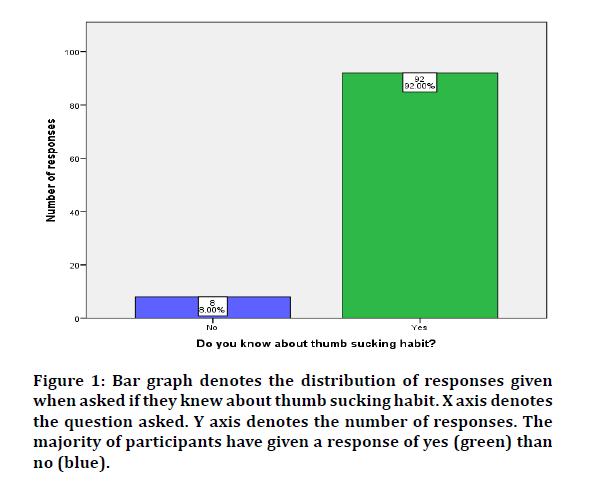
Figure 1: Bar graph denotes the distribution of responses given when asked if they knew about thumb sucking habit. X axis denotes the question asked. Y axis denotes the number of responses. The majority of participants have given a response of yes (green) than no (blue).
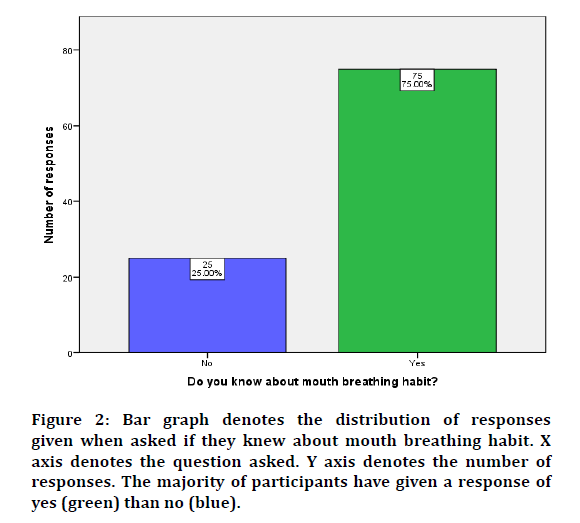
Figure 2: Bar graph denotes the distribution of responses given when asked if they knew about mouth breathing habit. X axis denotes the question asked. Y axis denotes the number of responses. The majority of participants have given a response of yes (green) than no (blue).
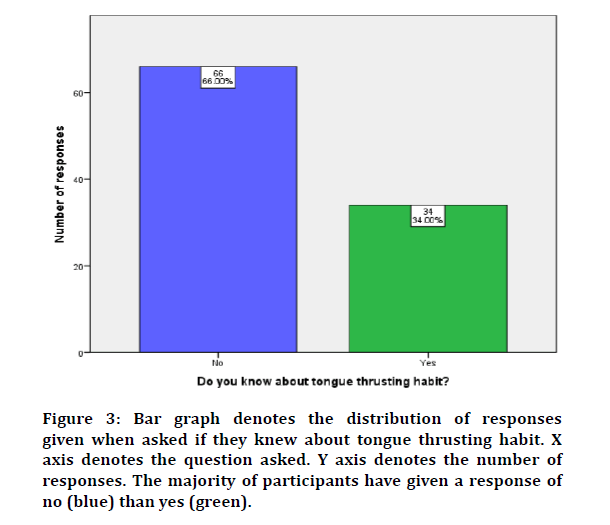
Figure 3: Bar graph denotes the distribution of responses given when asked if they knew about tongue thrusting habit. X axis denotes the question asked. Y axis denotes the number of responses. The majority of participants have given a response of no (blue) than yes (green).
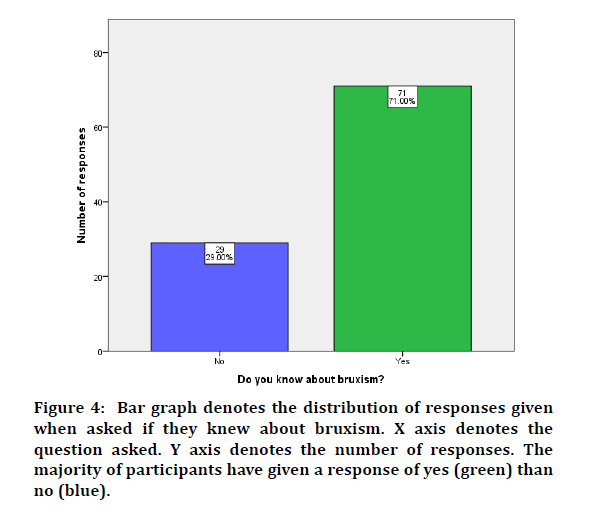
Figure 4: Bar graph denotes the distribution of responses given when asked if they knew about bruxism. X axis denotes the question asked. Y axis denotes the number of responses. The majority of participants have given a response of yes (green) than no (blue).
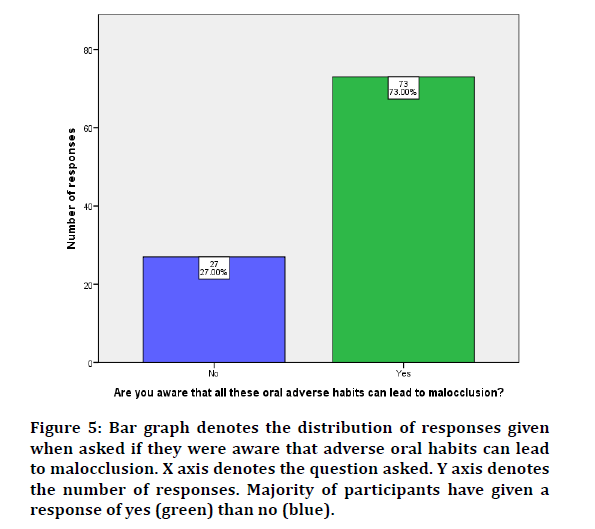
Figure 5: Bar graph denotes the distribution of responses given when asked if they were aware that adverse oral habits can lead to malocclusion. X axis denotes the question asked. Y axis denotes the number of responses. Majority of participants have given a response of yes (green) than no (blue).
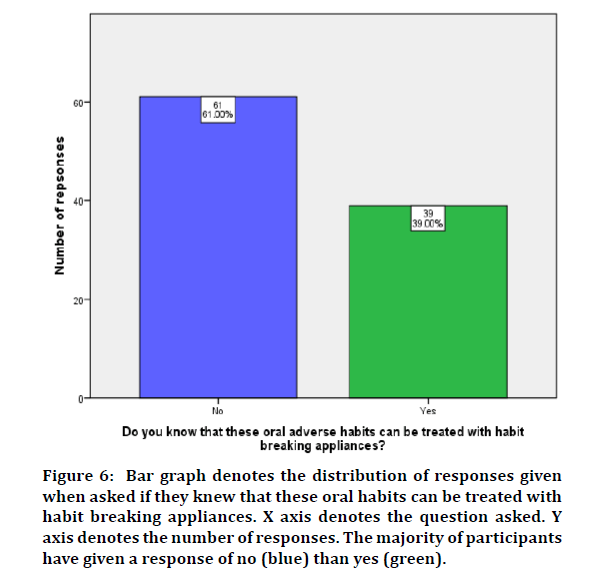
Figure 6: Bar graph denotes the distribution of responses given when asked if they knew that these oral habits can be treated with habit breaking appliances. X axis denotes the question asked. Y axis denotes the number of responses. The majority of participants have given a response of no (blue) than yes (green).
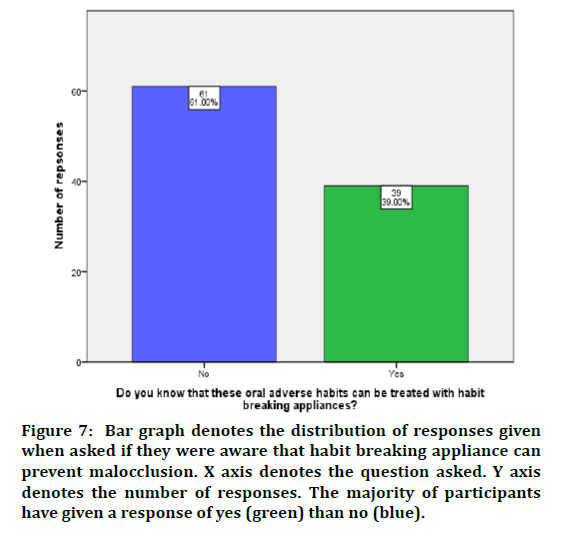
Figure 7: Bar graph denotes the distribution of responses given when asked if they were aware that habit breaking appliance can prevent malocclusion. X axis denotes the question asked. Y axis denotes the number of responses. The majority of participants have given a response of yes (green) than no (blue).
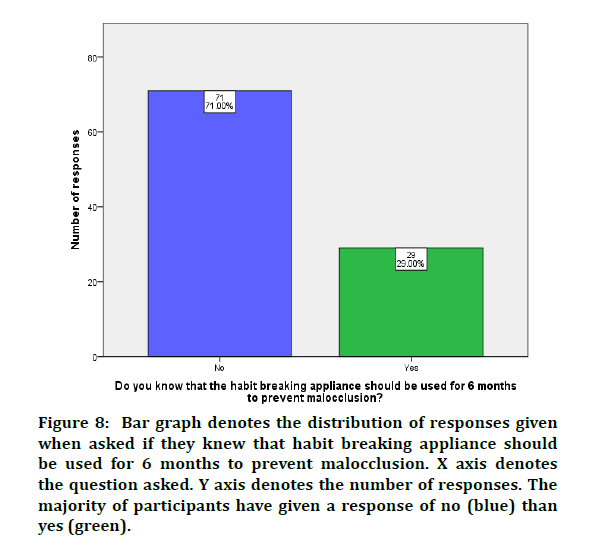
Figure 8: Bar graph denotes the distribution of responses given when asked if they knew that habit breaking appliance should be used for 6 months to prevent malocclusion. X axis denotes the question asked. Y axis denotes the number of responses. The majority of participants have given a response of no (blue) than yes (green).
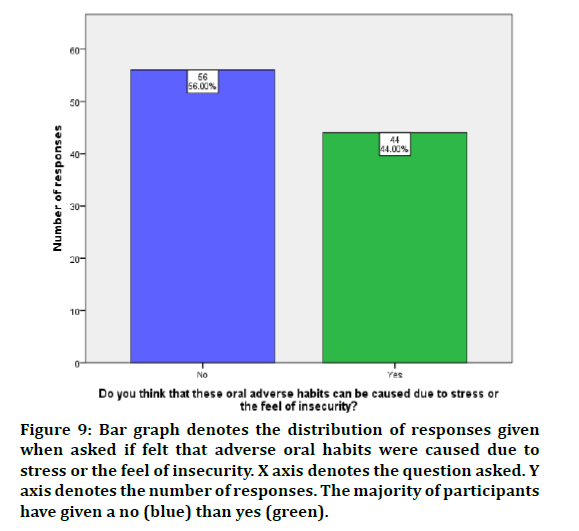
Figure 9: Bar graph denotes the distribution of responses given when asked if felt that adverse oral habits were caused due to stress or the feel of insecurity. X axis denotes the question asked. Y axis denotes the number of responses. The majority of participants have given a no (blue) than yes (green).
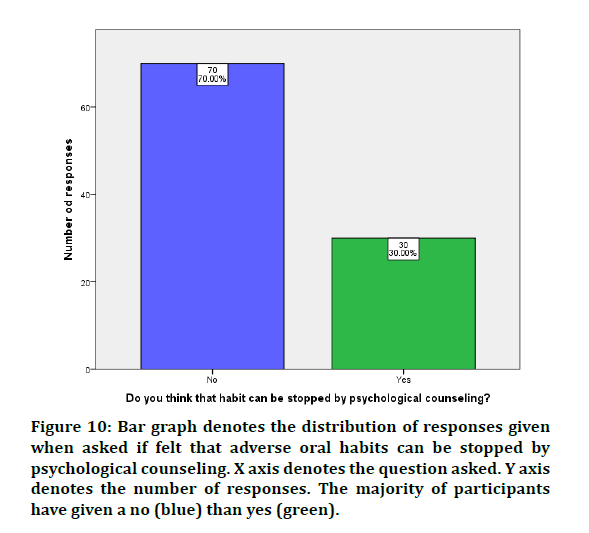
Figure 10: Bar graph denotes the distribution of responses given when asked if felt that adverse oral habits can be stopped by psychological counseling. X axis denotes the question asked. Y axis denotes the number of responses. The majority of participants have given a no (blue) than yes (green).
Among the respondents, a higher percentage of both males and females were aware that adverse oral habits can lead to malocclusion (46% males and 27% females) and also that usage of habit breaking appliances can prevent malocclusion (51% males and 32% females). However, this difference was statistically significant. (Chi square test; p=0.000) (Figures 11 and 12).
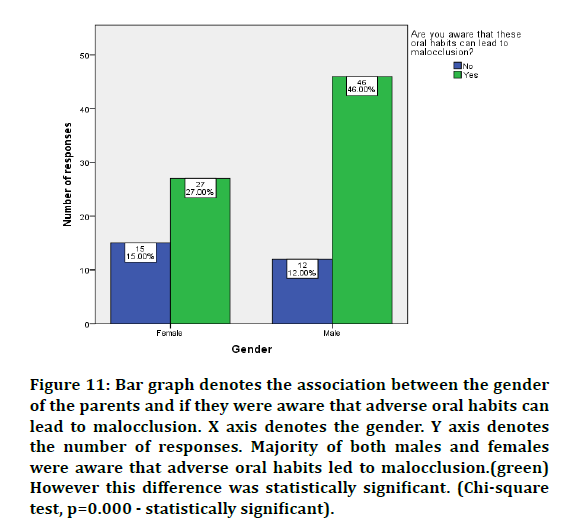
Figure 11: Bar graph denotes the association between the gender of the parents and if they were aware that adverse oral habits can lead to malocclusion. X axis denotes the gender. Y axis denotes the number of responses. Majority of both males and females were aware that adverse oral habits led to malocclusion.(green) However this difference was statistically significant. (Chi-square test, p=0.000 - statistically significant).
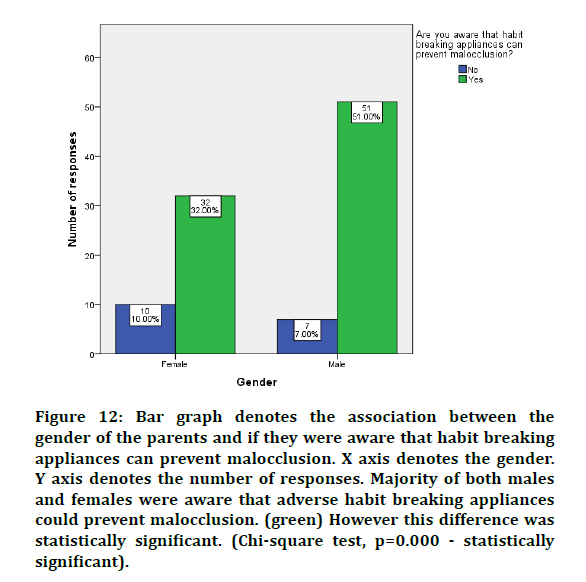
Figure 12: Bar graph denotes the association between the gender of the parents and if they were aware that habit breaking appliances can prevent malocclusion. X axis denotes the gender. Y axis denotes the number of responses. Majority of both males and females were aware that adverse habit breaking appliances could prevent malocclusion. (green) However this difference was statistically significant. (Chi-square test, p=0.000 - statistically significant).
In our study, it was seen that most of the parents knew about the adverse oral habits like thumb sucking, mouth breathing, and bruxism but were not aware of tongue thrusting habits. Most of the parents were aware that adverse oral habits cause malocclusion but did know that habit breaking appliances can treat adverse oral habits whereas they were aware that habit breaking appliances can prevent malocclusion. Most of the parents did not know that the habit breaking appliance should be used more than 6 months. Only a minority of the population felt that adverse oral habits can be caused due to stress or feel of insecurity. And they did not feel that psychological counseling can stop the adverse oral habits. It was seen that most males were aware that adverse oral habits can lead to malocclusion and usage of habit breaking appliances can prevent malocclusion.
In our study, it was reported that most of the parents were aware of their children’s oral health. Like our study, Mahesh et al. reported that there was 100% awareness among parents regarding the maintenance of oral hygiene among children. Approximately 53% of the parents thought it was important to treat primary teeth, whereas 30% thought it would depend on conditions [39].
Gurunathan et al. reported that it was found that neglecting dental health was more prevalent in urban populations [40]. Ng et al. reported that the treatment of primary teeth was considered exceptionally low in some cultures, and not much importance was given to caries and missing spaces in the primary dentition [41].
Parents play a major role in changing adverse habits of children since it affects the general health of children. Changing the habits in the correct age may prevent major problems at their adult age. Parents’ awareness related to regular dental checkup, inspecting oral cavity is about 36%. The parents monitoring the child for their parafunctional habits were quite less in the public. The parents who acted for their children’s parafunctional habits such as bruxism, tongue thrusting, and thumb sucking were only 37%. This would lead to malocclusion that would later need an orthodontic treatment to be done for their children. The parents monitoring the child for their parafunctional habits were quite less in the public. The parents who acted for their children’s parafunctional habits such as bruxism, tongue thrusting, and thumb sucking were only 37%. This would lead to malocclusion that would later need an orthodontic treatment to be done for their children [42].Studies also state that tongue thrusting habit was present at a prevalence rate of 33.65%, thumb sucking and accompanying proclination of teeth with open bite and cross bites [43].The advantage of the present study was that there was a high internal validity of the results and the results can be generalized to our study population. While the external validity of the present study was minimal due to smaller sample size and unicentric population. However, the future scope of this study would be to obtain responses with larger sample size and different ethnicities to obtain better relatable results.
Conclusion
Within the limitations of the study it was seen that the majority of the parents were aware that habit breaking appliances can be used to prevent malocclusion but most of them did not know that habit breaking appliances were used to treat adverse oral habits. More awareness programs can be conducted among parents to increase their knowledge on the adverse oral habits, it’s long term effects, and usage of habit breaking appliances.
Acknowledgement
The authors acknowledge all the parents who provided consent and spent their time on completing this survey.
Conflict of Interest
The authors of the study declare that there were no conflicts of interest.
References
- Garn SM. The aetiology of irregularity and malocclusion of the teeth. 2nd Edn part 1, by Brash JC. Part 2 by McKeag HTA, Scott JH, with an appendix by Tildesley ML. xiv 503 pp. $6.00. Dental board of the United Kingdom, London. Am J Phy Anthropol 1957; 297–298.
- Boeck EM, Pizzol KEDC, Barbosa EGP, et al. Prevalência de má oclusão em crianças de 3 a 6 anos portadoras de hábito de sucção de dedo e/ou chupeta. Revista Odontologia 2013; 42:110–116.
- Garde JB, Suryavanshi RK, Jawale BA,et al. An epidemiological study to know the prevalence of deleterious oral habits among 6 to 12 year old children. J Int Oral Health 2014; 6:39–43.
- Suhani RD, Suhani MF, Muntean A, et al. Deleterious oral habits in children with hearing impairment. Clujul medical 2015; 88:403–407.
- Sharma S, Bansal A, Asopa K. Prevalence of oral habits among eleven to thirteen years old children in Jaipur. Int J Clin Pediatr Dent 2015; 8:208–210.
- Shahraki N, Yassaei S, Moghadam MG. Abnormal oral habits: A review. J Dent Oral Hygiene 2012; 2:12–15.
- Traisman AS, Traisman HS. Thumb and finger sucking: A study of 2,650 infants andchildren. J Pediatr 1958; 52:566–572.
- Kr S, Dk S. Oral habits in school going children of Delhi: A prevalence study. J Indian Society Pedodont Preventive Dent 2003; 21:120–124.
- Miremadi SA, Khoshkhounejad AA, Mahdavi E. The prevalence of tongue thrusting in patients with periodontal disease. Frontiers Dent 2005; 50–53.
- Larsson E. Sucking, chewing, and feeding habits and the development of crossbite: A longitudinal study of girls from birth to 3 years of age. Angle Orthodont 2001; 71:116–119.
- Sowjanya V, Thakur MS, Thakur M, et al. Aesthetic rehabilitation of a child with missing anterior teeth and thumb sucking habit using fixed functional space maintainer in combination with habit breaking appliance. Annals Essences Dent 2013; 5:15–17.
- Haryett R, Hansen FC, Davidson PO, et al. Chronic thumb-sucking: The psychologic effects and the relative effectiveness of various methods of treatment. Am J Orthodont 1967; 53:569–585.
- Singh S, Dua P, Jain S. Habit breaking appliance for tongue thrusting-A modification. Indian J Dent Sci 2011; 3:10-12.
- Villa NL, Cisneros GJ. Changes in the dentition secondary to palatal crib therapy in digit-suckers: a preliminary study. Pediatr Dent 1997; 19:323–326.
- Al-Tamimi S, Petersen PE. Oral health situation of schoolchildren, mothers, and schoolteachers in Saudi Arabia. Int Dent J 1998; 48:180–186.
- Petersen PE, Esheng Z. Dental caries, and oral health behaviour situation of children, mothers and schoolteachers in Wuhan, People’s Republic of China. Int Dent J 1998; 210–216.
- Hood CA, Hunter ML, Kingdon A. Demographic characteristics, oral health knowledge and practices of mothers of children aged 5 years and under referred for extraction of teeth under general anaesthesia. Int J Paediatr Dent 1998; 8:131–136.
- Saravanan S, Kalyani V, Vijayarani MP, et al. Caries prevalence and treatment needs of rural school children in Chidambaram Taluk, Tamil Nadu, South India. Indian J Dent Res 2008; 19:186–190.
- Gurunathan D, Moses J, Arunachalam SK. Knowledge, attitude, and practice of mothers regarding oral hygiene of primary school children in Chennai, Tamil Nadu, India. Int J Clin Pediatr Dent 2018; 11:338–343.
- Govindaraju, L, Jeevanandan G, Subramanian EMG. (2017a) Comparison of quality of obturation and instrumentation time using hand files and two rotary file systems in primary molars: A single-blinded randomized controlled trial. Eur J Dent 2017; 11:376–379.
- Govindaraju, L, Jeevanandan G, Subramanian EMG. Knowledge and practice of rotary instrumentation in primary teeth among Indian dentists: A questionnaire survey. J Int Oral Health 2017; 9:45.
- Panchal V, Gurunathan D, Shanmugaavel AK. Smartphone application as an aid in determination of caries risk and prevention: A pilot study. Eur J Dent 2017; 11:469–474.
- Ravikumar D, Jeevanandan G, Subramanian EMG. Evaluation of knowledge among general dentists in treatment of traumatic injuries in primary teeth: A cross-sectional questionnaire study. Eur J Dent 2017; 11:232–237.
- Jeevanandan G, Govindaraju, L. Clinical comparison of Kedo-S paediatric rotary files vs manual instrumentation for root canal preparation in primary molars: A double blinded randomised clinical trial. Eur Archives Paediatr Dent 2018; 19:273–278.
- Nair M, Jeevanandan G, Vignesh R, et al. Comparative evaluation of post-operative pain after pulpectomy with k-files, kedo-s files and mtwo files in deciduous molars-A randomized clinical trial. Brazilian Dent Sci 2018; 21:411.
- Ravikumar D, Gurunathan D, Gayathri R, et al. DNA profiling of Streptococcus mutans in children with and without black tooth stains: A polymerase chain reaction analysis. Dent Res J 2018; 15:334.
- Ravikumar D, Ramakrishna M, Sharna N, et al. Evaluation of McNamara’s analysis in South Indian (Tamil Nadu) children between 8-12 years of age using lateral cephalograms. J Oral Biol Craniofac Res 2019; 9:193–197.
- Ravindra V, Rekha V, Annamalai S, et al. A comparative evaluation between dermatoglyphic patterns and different terminal planes in primary dentition. J Clin Exp Dent 2018; 10:e1149–e1154.
- Ravindra V, Rekha CV, Annamalai S, et al. A comparative evaluation between cheiloscopic patterns and the permanent molar relationships to predict the future malocclusions. J Clin Exp Dent 2019; 11:e553–e557.
- Subramanyam D, Gurunathan D, Gaayathri R, et al. Comparative evaluation of salivary malondialdehyde levels as a marker of lipid peroxidation in early childhood caries. Eur J Dent 2018; 12:67–70.
- Vishnu Prasad S, Kumar M, Ramakrishnan M, et al. Report on oral health status and treatment needs of 5-15 years old children with sensory deficits in Chennai, India. Special Care Dent 2018; 38:58–59.
- Jeevanandan G, Ganesh S, Arthilakshmi. Kedo file system for root canal preparation in primary teeth. Indian J Dent Res 2019; 30:622–624.
- Ramadurai N, Gurunathan D, Samuel AV, et al. Effectiveness of 2% Articaine as an anesthetic agent in children: randomized controlled trial. Clin Oral Investigations 2019; 23:3543–3550.
- Ramakrishnan M, Dhanalakshmi R, Subramanian EMG. Survival rate of different fixed posterior space maintainers used in paediatric dentistry-A systematic review. Saudi Dent J 2019; 31:165–172.
- Panchal V, Jeevanandan G, Subramanian E. Comparison of instrumentation time and obturation quality between hand K-file, H-files, and rotary Kedo-S in root canal treatment of primary teeth: A randomized controlled trial. J Indian Society Pedodontics Preventive Dent 2019; 37:75–79.
- Vignesh R, Ditto Sharmin C, Annamalai S, et al. Management of complicated crown-root fracture by extra-oral fragment reattachment and intentional reimplantation with 2 years review. Contemporary Clin Dent 2019; 10:397–401.
- Panchal V, Jeevanandan G, Subramanian EMG. Comparison of post-operative pain after root canal instrumentation with hand K-files, H-files and rotary Kedo-S files in primary teeth: A randomised clinical trial. Eur Archives Paediatr Dent 2019; 20:467–472.
- Samuel SR, Acharya S, Rao JC. School interventions-based prevention of early-childhood caries among 3-5-year-old children from very low socioeconomic status: Two-year randomized trial. J Public Health Dent 2020; 80:51–60.
- Ramakrishnan M, Banu S, Ningthoujam S, et al. Evaluation of knowledge and attitude of parents about the importance of maintaining primary dentition-A cross-sectional study. J Family Med Primary Care 2019; 8:414–418.
- Gurunathan D, Shanmugaavel A. Dental neglect among children in Chennai. J Indian Society Pedodont Preventive Dent 2016; 34:364.
- Ng MW. Multicultural influences on child-rearing practices: Implications for today’s pediatric dentist. Pediatr Dent 2003; 25:19–22.
- Priyanka S, Mahesh R, Leelavathi L. Awareness and role of parents in their child’s oral health and brushing technique-A questionnaire study. 2018; 10.
- Hegde M, Xavier A. Childhood habits: Ignorance is not Bliss- A prevalence study. Int J Clin Pediatr Dent 2009; 2:26–29.
Author Info
Vishnu Prasanna SG, Vignesh Ravindran* and Keerthi Sasanka L
Department of Prosthodontics, Saveetha Dental College, Saveetha Institute of Medical and Technical Sciences, Saveetha University, Chennai, IndiaCitation: Vishnu Prasanna SG, Vignesh Ravindran, Keerthi Sasanka L,Knowledge and Awareness on Habits and Habit Breaking Appliances Among Parents-A Questionnaire Survey, J Res Med Dent Sci, 2020, 8 (7): 122-128.
Received: 15-Sep-2020 Accepted: 16-Oct-2020 Published: 23-Oct-2020
